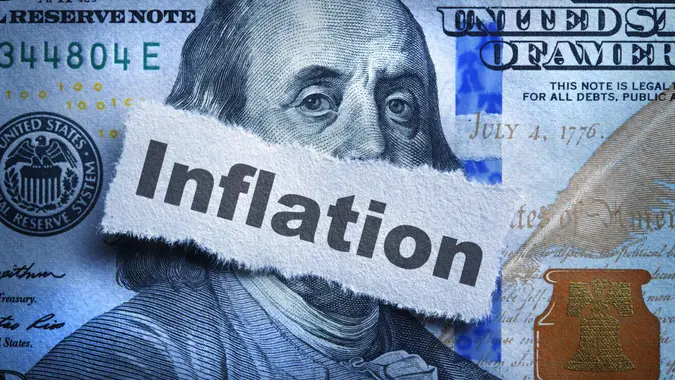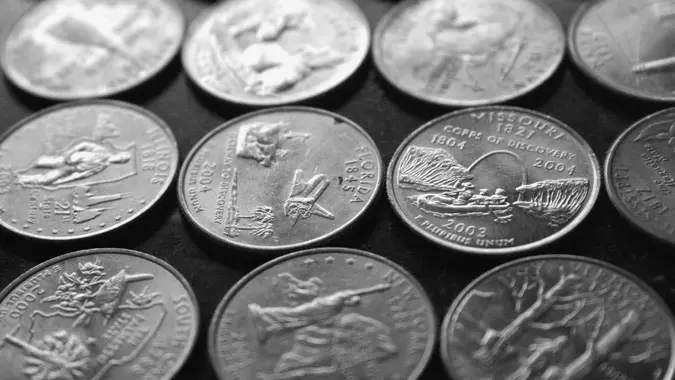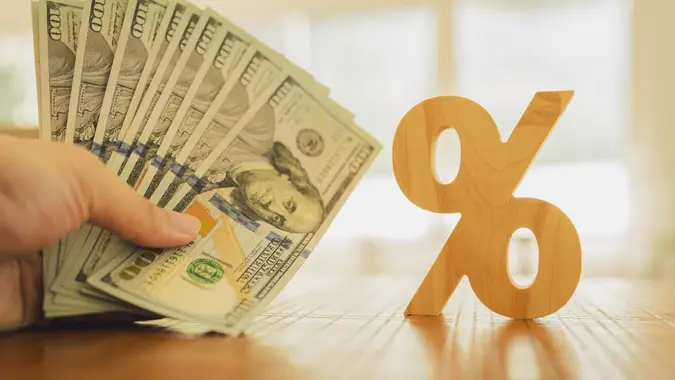What Causes Inflation?

Commitment to Our Readers
GOBankingRates' editorial team is committed to bringing you unbiased reviews and information. We use data-driven methodologies to evaluate financial products and services - our reviews and ratings are not influenced by advertisers. You can read more about our editorial guidelines and our products and services review methodology.

20 Years
Helping You Live Richer

Reviewed
by Experts

Trusted by
Millions of Readers
Inflation has been one of the bugaboos of the post-pandemic era, increasing from 2.3% in December 2019, as measured by the Consumer Price Index, to 9.8% at its peak in June 2022, driving up prices around the country and wreaking havoc on everything from consumer budgets to stock market prices.
The CPI has fallen dramatically in the two-plus years since that peak, but at 2.9% as of July, it’s still significantly higher than the 2% goal set by the Federal Reserve.
Below, you can see the inflation changes over the past two years, broken down by region which illustrates how inflation might be affecting you.
Key Findings by Region
- The Mountain division of the Western U.S. had the highest inflation rate in 2022, but it has the lowest rate in 2024 — 2.0% compared to the national average of 2.9% as of July. The Mountain division includes Arizona, Colorado, Idaho, Montana, Nevada, New Mexico, Utah and Wyoming.
- The New England region which includes Connecticut, Maine, Massachusetts, New Hampshire, Rhode Island and Vermont, had the lowest inflation rate in July 2022 at 7.3%. However, by July 2024, it saw an increase to 3.5%, indicating more persistent inflation.
- The East North Central division of the Midwest, which includes states like Illinois, Indiana, Michigan, Ohio and Wisconsin, had an inflation rate of 8.8% in July 2022. By July 2024, it decreased to 2.4%, showing a significant decline but not as low as the Mountain division.
Below, you can find out how inflation has shifted over the last year, broken down by the largest states.
Key Findings by State
- New York experienced the highest inflation rate among the largest states in each U.S. region in 2024 at 3.7%, up from 2.8% in 2023.
- Massachusetts had a significant rise in inflation, with the rate increasing from 2.1% in 2023 to 3.5% in 2024. This makes the New England region an area with persistent inflation issues.
- Arizona saw the most significant drop in inflation rates, decreasing from 3.5% in 2023 to 2.0% in 2024, positioning the Mountain division as the region with the lowest inflation in 2024.
What Causes Inflation?
Inflation occurs when rising demand, diminishing supply and expansionary fiscal and monetary policies drive prices higher. Although inflation remained low for years, it surged in 2022, leaving many Americans wondering why it came back so forecfully and continues to remain stubbornly high.
Read on for more detailed information about the causes of inflation, particularly how they relate to 2024.
Key Takeaways
- The supply/demand equation plays a big role in inflation.
- Fiscal and monetary policies also have a big influence.
- Inflation is cyclical.
Rising Demand
One of the classic definitions of inflation is “too much money chasing too few goods.”
A more accessible version of this axiom, perhaps, is that when customers demand more of a product than exists, its price goes up. That’s a simple economic concept that makes plenty of sense if you look at things from the perspective of a business owner.
Imagine that you produce a popular product that keeps selling out — one that you can never keep in stock in your inventory, no matter how much you produce. The prudent course of action in this case is to raise your prices.
Demand-Pull Inflation
Now, imagine a booming economy in which consumers are flush with cash and buying everything in sight, depleting inventories across a number of industries. Prices will naturally rise across the board, resulting in widespread inflation.
This type of economic environment is known as “demand-pull” inflation, as the demand for goods and services pulls prices higher in the economy at large.
Demand-pull inflation can also appear even if, strictly speaking, demand isn’t particularly high. Anything that puts the supply/demand equation out of balance will result in demand-pull inflation. So even if demand isn’t off the charts, if supply is limited, the same effect can occur.
Supply chain disruptions made headlines in 2022 as manufacturers of many products, from cars to computer chips, were unable to keep up with demand at a time when Americans were flush with extra cash from pandemic stimulus. This was one of the many contributing factors to high inflation in 2022.
Cost-Push Inflation
Known as cost-push inflation, rising prices can drive up the cost of production for businesses, which must ultimately pass those costs along to consumers in the form of rising prices — thereby creating more inflation.
What costs do employers face? There’s quite a long list, actually, and each component can contribute to inflation. Over time, most employers have to pay out rising wages. While noting that wages can increase to a level that exceeds inflation without having a major effect on it, an analysis by the Federal Reserve Bank of Boston documented a strong correlation between consumer price inflation and the Employment Cost Index.
Increases can also result from government regulation. California, for example, was one of the first states to raise its minimum wage to $15 an hour — well above the federal requirement of $7.25 an hour — and it since has ticked up to $16 an hour, with fast food employees earning at least $20 per hour.
Employers also have to deal with the rising cost of benefits, from 401(k) fees to health insurance, and this is on top of the expense of the raw materials some businesses require, from oil to copper to countless other raw materials costs.
At the end of the day, as the cost of doing business rises, so too does the cost of the goods and services that businesses provide. Ultimately, this translates into consumer inflation.
Contributors to Rising Inflation
Beyond rising employer costs and supply and demand issues, there are a number of macroeconomic factors that play a role in rising inflation. Two of the most prominent of these are fiscal policy and monetary policy.
Fiscal Policy
Fiscal policy refers to how a government handles things such as taxation and spending to influence consumer activity and the economy overall.
Probably the most noteworthy example of fiscal policy influencing inflation in recent times has been the massive stimulus packages provided by the government starting in 2020. Primarily in the form of stimulus checks and other advance tax credits and forgivable business loans, the trillions of dollars in stimulus distributed by the U.S. government most likely played a role in triggering the inflationary pressures seen in 2021 and 2022.
Monetary Policy
Monetary policy refers to the actions of central banks, like the U.S. Federal Reserve, to control the money supply. When the Fed lowers interest rates, as it did at the onset of the COVID-19 pandemic in 2020, it creates an expansionary monetary policy, which increases the money supply and makes it cheaper for both businesses and consumers to operate.
However, when monetary policy is left in an expansionary position for too long, inflation is prone to rise. This is the battle the Fed is currently waging. After years of low federal funds rates, and a reduction to near-0% to encourage spending during the pandemic, inflation shot up to its highest level in over 40 years, prompting the Fed to aggressively raise rates to keep inflation in check.
Of course, the Fed can often overshoot its mark and leave monetary policy too tight for too long, which can result in a recession. This is the fear that many economists had last year. However, in the second half of 2024, most expect a “soft landing” — continued reduction in inflation while avoiding a recession.
Who Benefits From Inflation?
Rapid gains in inflation tend to be harmful for everyone, as they generally lead to out-of-control prices and a recessionary economy. However, modest levels of inflation can benefit many.
- Companies can charge higher prices in a slightly inflationary economy, potentially leading to higher profits and better returns for investors.
- Those with large, fixed-rate loans, such as home mortgages, benefit from rising inflation, as they are paying their housing costs with more valuable dollars.
- Investors holding Treasury Inflation-Protected Securities, or TIPS, can also benefit from increased returns in an inflationary environment — but you should speak with a financial advisor to fully understand these complicated securities.
What You Should Know About National Inflation
Inflation is a complicated economic concept that results in higher prices for goods and services. The federal government generally keeps inflation to a relatively narrow range, based on a combination of fiscal and monetary policy, but as the business cycle ebbs and flows, it tends to push up or drag down inflation along with it.
Inflation Varies by State
The CPI is a national average inflation rate, but where in the country you live also plays a role on the price increases you experience. The BLS doesn’t measure inflation rates on a state-by-state basis, but it does measure it by regions and by narrower categories it calls divisions.
Changes in population size is a major factor, in part because of its influence on housing costs, which have been a primary driver of inflation. An analysis by Moody’s Analytics revealed that population growth correlates with higher inflation due to increased housing demand, and that shrinking population correlates even more strongly with decreases in inflation. So you can expect that the states seeing the largest increases in new residents have higher inflation during the influx, but their inflation rates fall more sharply as people move out again.
Other more local factors include prices for food and other difficult-to-transport products, local business and industry trends and energy and fuel usage.
FAQ
Here are some quick answers to common questions about inflation.- What does inflation mean?
- The word "inflation" refers to an increase in the prices consumers pay for goods and services.
- What is the inflation rate in the U.S. today?
- According to the most recent data from the U.S. Department of Labor Bureau of Labor Statistics, which publishes national inflation data every month, the inflation rate is 2.9% as of July 2024.
- What is the main cause of inflation?
- Supply and demand imbalance and fiscal and monetary policy play a significant role in causing inflation.
- What caused inflation in 2022?
- A major cause of inflation in 2022 was the supply chain issues caused by the COVID-19 pandemic -- as goods became scarce, prices went up in response to continued demand.
- The stimulus checks and loans provided by the federal government also played a role, as well as long-lasting low interest rates.
- What is causing inflation in 2024?
- The factors that contributed to inflation in the U.S. in 2022 are having an effect in 2024. However, the Federal Reserve's monetary policy, which increased federal interest rates to slow the economy, has been successful in bringing inflation down, although not yet to the 2% rate that is the Fed's goal.
Daria Uhlig contributed to the reporting for this article.
For this study, GOBankingRates analyzed the 12-month change in percentage for the Consumer Price Index (CPI) for each state. First GOBankingRates found the BLS region and BLS division for each state from the Bureau of Labor Statistics Local Area Unemployment Statistics. Next GOBankingRates found the 12-month percentage change for the CPI for each BLS division for every three months in the last two years starting with January 2022 and ending with July 2024 as that is the most up-to-date data available. Each data point represents the percentage change from 12 months prior. All data was collected on and is up to date as of Aug. 14, 2024.
Our in-house research team and on-site financial experts work together to create content that’s accurate, impartial, and up to date. We fact-check every single statistic, quote and fact using trusted primary resources to make sure the information we provide is correct. You can learn more about GOBankingRates’ processes and standards in our editorial policy.
- Richmond Federal Reserve. 2024. "Federal Reserve Economic Focus Q1/Q2 2024."
- Boston Federal Reserve. 2024. "Is Post-Pandemic Wage Growth Fueling Inflation?"
- Reuters. 2024. "Market Fed Piloting Another Tricky Soft Landing."
- Economic Innovation Group (EIG). 2024. "The Geography of U.S. Inflation: Prices Are Rising Faster in Lower-Cost States."
- St. Louis Federal Reserve. 2022. "Variations in Inflation Across U.S. Metro Areas."
- Fox 13 News. 2023. "Floridians Battle 5th Highest Inflation Rate in the Nation."
- U.S. Bureau of Labor Statistics. 2023. "Consumer Price Index Historical Data."
- U.S. Bureau of Labor Statistics. 2023. "CPI News Release."
 Written by
Written by  Edited by
Edited by 




























